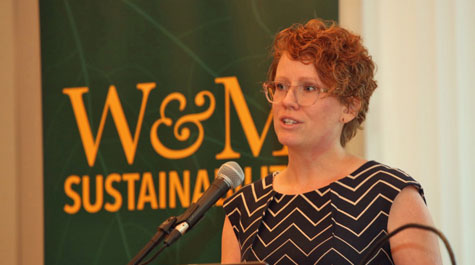W&M sustainability director shares tips for greener holidays
Being mindful about what one is buying, using and disposing of is half the battle in planning for a more environmentally friendly holiday season, according to William & Mary Director of Sustainability Calandra Waters Lake.
W&M News recently spoke with Waters Lake about how people can lessen their impact on the Earth while celebrating the holidays. She used her own family’s holiday practices as a guide.
“We’re trying to keep in mind that our carbon footprint is something that can expand during the holidays,” Waters Lake said. “And so how can we be wise about that through our purchases, through food that we eat, through the activities that we’re doing? Just trying to keep that in mind even though things get busy around the holidays.”
Here are her tips for ways to do just that.
Gift giving
- First, step back and remember that the reason for the gift is to show someone you care. So, is buying a gift the best way to do that? Going out and doing something with the recipient to spend time with them may be a better option.
- If you’re going to give an item, decide whether it’s something you will make or purchase. Either way, evaluate both to consider whether the recipient is actually going to use the gift or if it’s just going to be one more thing.
- When purchasing materials to make the gift or the gift itself, consider where it’s coming from and what it’s made out of. Could it be from recycled content or be Fair Trade? Also, consider quality, longevity, what’s going to happen when the recipient finishes using it, and if that’s the best use of the gift-giving opportunity.
- Consider barring novelty items, also known as gag gifts. Instead, do something like run a text message chain throughout the holidays sharing links and photos of such gifts they thought the other person would laugh at, but that they didn’t buy.
- Consider the clutter factor when making final gifting decisions. Food or other consumables such as handmade soaps are good options, and farmers markets are good resources for unique local items that come with little packaging.
Gift wrapping
- Think first does the item even need to be wrapped? One suggestion is a scavenger hunt to find gifts hidden around the house.
- Consider making the wrapping part of the gift, such as a scarf, reusable container or bag.
- Turn brown paper bags decorated with coloring and stamps into a craft project that results in unique wrapping paper. Stay away from foil wrapping paper that is not recyclable.
Decorating
- Use natural materials from the outdoors as much as possible. This cuts down on the amount of seasonal decor that has to be stored for the rest of the year.
- Put thought into items that you buy so that they will be used every year for the long term.
- Go for compostable or recyclable on most things. Collecting and painting pine cones, for example, provides decorations.
- Stay away from plastic. One alternative is wool balls that can be made into bright and colorful decorations.
Food
- Plan how much food you will realistically use so that you can plan what to buy. Freezing or sending home with friends is a good way to hold off food waste from leftovers sitting in the fridge for too long.
- Food scraps can be used in other recipes, so broccoli stems or turkey bones could be used for soups later on. It’s important to use all of the items.
- Because food can be a large part of one’s carbon, or greenhouse gas, footprint, make the most of the item. Purchasing food that is humanely raised and organic is part of that.
Cards
- Possibly send paper holiday cards only to those who really appreciate receiving them, and go with e-cards for everybody else.
- For paper cards, keep it simple and recyclable. Either recycled or Forest Stewardship Council certified is best. Avoid cards with glitter, metals or any kind of attached material that makes them harder to recycle.
- A small donation to a charity in the recipient’s name may work just as well and have a longer lasting impact for the expense.
Starting the conversation
Letting people know what you’d prefer to receive can be a difficult area to talk about, but the global impact of consumption is becoming a more common topic, according to Waters Lake.
One example is parents of young children who are trying to cut down on the amount of plastic coming into their homes. Wrapping that conversation into a larger one about wanting fewer things and being conscious about what’s coming into the home is one way to go about it, she said.
Providing websites that feature items made of mostly wood or cloth that are preferred is another possibility. Experiences such as a museum membership are also alternatives to suggest.
It’s more difficult to talk with people who aren’t as close as family about gift preferences, but received items can be donated or returned, Waters Lake added.
All holiday-related preferences can be worked into conversations.
“Through how we talk about raising our children, and how we talk about the things that are in our lives, we’ve tried to imply that in general, we’re not purchasing these items,” Waters Lake said. “Not just the toys for our kids, but the things that are coming into our house for the holidays, the food that we’re eating as a family. Across the board, we’re trying to reduce our footprint.
“We let them know, there are a lot of impacts from plastic on this planet and the evidence for that just continues to rise. We are all seeing more of that in the news, so it becomes an easier conversation every year.”
 Skip to main content
Skip to main content

